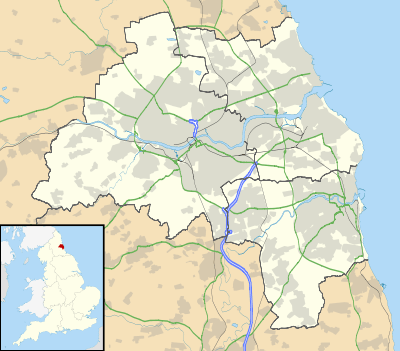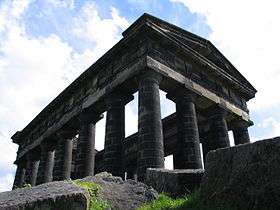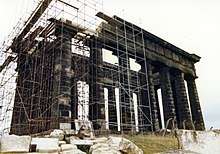Penshaw Monument
| Penshaw Monument | |
|---|---|
 Penshaw Monument, from Herrington Country Park | |
 Location within Tyne and Wear | |
| Alternative names | The Earl of Durham's Monument |
| General information | |
| Type | Memorial |
| Architectural style | Doric tetrastyle |
| Town or city | Penshaw, Sunderland, Tyne and Wear |
| Country | England |
| Coordinates | 54°52′59″N 1°28′52″W / 54.883°N 1.481°W |
| Elevation | 136 m (446 ft) |
| Construction started | 28 August 1844 |
| Renovated | 1978–1979 |
| Cost | £6,000 |
| Client | Charles Vane, 3rd Marquess of Londonderry |
| Owner | National Trust |
| Management | National Trust |
| Height | 20 m (66 ft) |
| Design and construction | |
| Architect | John and Benjamin Green |
| Engineer | Thomas Pratt, Sunderland |
The Penshaw Monument (/ˈpɛnʃə/), officially The Earl of Durham's Monument,[1] was built in 1844 on Penshaw Hill between the districts of Washington and Houghton-le-Spring, within the City of Sunderland, North East England. It is dedicated to John George Lambton (1792–1840), 1st Earl of Durham and the first Governor of the Province of Canada and affectionately known as Radical Jack.
Penshaw monument was built as a memorial to John Lambton's work on the Durham report which was commissioned by Lord Melbourne in 1838 to seek direction on how best the British Empire should manage its colonies around the globe. The report recommended nearly complete self governance for advanced colonies and became one of the most important documents in the whole of the British Empire, formulating a new relationship between London and the colonies.
Location
The 136-metre (446 ft) hill on which the monument stands was presented by Charles Vane, 3rd Marquess of Londonderry. The monument dominates the local landscape as a half-sized replica of the Temple of Hephaestus in Athens.[2] It is floodlit at night.[3]
Toponymy
Although often called "the Penshaw Monument", the correct title of the structure is The Earl of Durham's Monument.[2]
The monument stands on Penshaw Hill, the name of which is derived from a mixture of Celtic and Anglo-Saxon words. Pen is a Brythonic or Cumbric word for hill, as in the name Penrith; shaw is derived from sceaga meaning "wooded area"; and finally the Old/Middle/Modern English word "hill". The name thus means "wooded-hill hill".
Construction
The Doric tetrastyle monument is 30 metres (98 ft) long, 16 metres (52 ft) wide and 20 metres (66 ft) high.[4] The columns are each 2 metres (6 ft 7 in) in diameter. It was designed by John and Benjamin Green and built by Thomas Pratt of Sunderland,[5] based on the Doric order.
Resting on the columns is the entablature which itself can be split into three main parts. The architrave is the main spanning beam across the tops of the pillars. Above the architrave is the frieze, the central patterned section. Then the cornice is the upper part which projects outwards. Finally, the pediments are the triangular facings at each end of the Monument. One of the pillars contains a spiral staircase to a walkway around the top of the monument.
The Monument is made of gritstone from the Marquess of Londonderry's quarries on the east coast.[6] Steel pins and brackets were used to hold the stone blocks in place.
History

The foundation stone was laid by Thomas Dundas, 2nd Earl of Zetland (the Grand Master of the United Grand Lodge of England) on 28 August 1844, four years after the death of John Lambton.[7]
On Easter Monday 1926 a 15-year-old boy from Fatfield, Temperley Arthur Scott, fell to his death from the top of the Penshaw Monument. The boy was with three friends and 20 other people when the accident happened. They had reached the roof via the spiral staircase in one of the pillars. Afterwards the spiral staircase to the roof was closed and remained so until 2011, when the public were again granted access to the spiral staircase and views from the top of the monument.
In September 1939 John Lambton, 5th Earl of Durham gave the Penshaw Monument to the National Trust.
Owing to settlement as a result of mining beneath the hill, the Penshaw Monument was underpinned in 1978. The next year the entire western end was dismantled block by block in order that damaged lintels could be replaced by new reinforced concrete ones.


In 1983, local punk rock band Toy Dolls filmed the music video for their single "Dig That Groove Baby", taken from the album of the same name, inside the monument.
The Penshaw Monument features on the club badge of Sunderland A.F.C.
Placard
It was acquired by the National Trust as a gift from the 5th Earl of Durham in 1939.[2] A placard was placed on the front of the monument to recognise this.
The placard reads:
THIS STONE WAS LAID BY
THOMAS, EARL OF ZETLAND
GRAND MASTER OF THE FREE AND ACCEPTED MASONS OF ENGLAND
ASSISTED BY
THE BRETHREN OF THE PROVINCES OF DURHAM AND NORTHUMBERLAND
ON THE 28TH AUGUST 1844
BEING THE FOUNDATION STONE OF A MEMORIAL TO BE ERECTED
TO THE MEMORY OF
JOHN GEORGE EARL OF DURHAM
WHO
AFTER REPRESENTING THE COUNTY OF DURHAM IN PARLIAMENT
FOR FIFTEEN YEARS
WAS RAISED TO THE PEERAGE
AND SUBSEQUENTLY HELD THE OFFICES OF
LORD PRIVY SEAL, AMBASSADOR EXTRAORDINARY AND
MINISTER AT THE COURT OF ST. PETERSBURG AND
GOVERNOR-GENERAL OF CANADA.
HE DIED ON THE 28TH OF JULY 1840 IN THE 49TH YEAR OF HIS AGE
THE MONUMENT WILL BE ERECTED
BY THE PRIVATE SUBSCRIPTIONS OF HIS FELLOW COUNTRYMEN
ADMIRERS OF HIS DISTINGUISHED TALENTS AND
EXAMPLARY PRIVATE VIRTUES.
DONATED TO THE NATIONAL TRUST ON 1ST SEPTEMBER 1939
External links
- Archived 12 July 2007 at the Wayback Machine. History of the site
- View 1: Penshaw Monument – Interactive 360° inside
- View 2: Penshaw Monument – Interactive 360° outside
- Detailed information about the structure and the boy's death
- Penshaw Monument at Houghton Heritage Society, featuring old photographs and information about the Monument's viewing platform
References
- ↑ Penshaw Monument | National Trust
- 1 2 3 ‘Disgraceful’ vandalism attack on Penshaw Monument - Sunderland Echo
- ↑ Penshaw Monument: New floodlights for Wearside landmark - BBC News
- ↑ https://www.chroniclelive.co.uk/news/north-east-news/penshaw-monument-supposed-roof-look-12223280
- ↑ https://www.chroniclelive.co.uk/news/north-east-news/penshaw-monument-supposed-roof-look-12223280
- ↑ https://www.chroniclelive.co.uk/news/north-east-news/penshaw-monument-supposed-roof-look-12223280
- ↑ https://www.sunderlandecho.com/lifestyle/retro/feature-170-years-of-penshaw-monument-1-6399823
